Methods
In this chapter we summarize the methods used to define indicators, analyze data, and summarize information included in this report, such as human footprint, biodiversity intactness, and sector effects.
120 ABMI sites
in Norbord's operating areas, including 95 sites in the Northern Operating Area and 25 in the Southern Operating Area. As of 2019, 34 of 95 sites had been sampled in the north, and 19 of 25 sites had been sampled in the south.
The ABMI monitors the state of Alberta’s land cover and biodiversity, including in Norbord's operating areas. Methods are summarized for:
- Land cover metrics including: human footprint, linear footprint, and interior native habitat.
- Biodiversity metrics including: biodiversity intactness index, sector effects, and landbase change attribution.
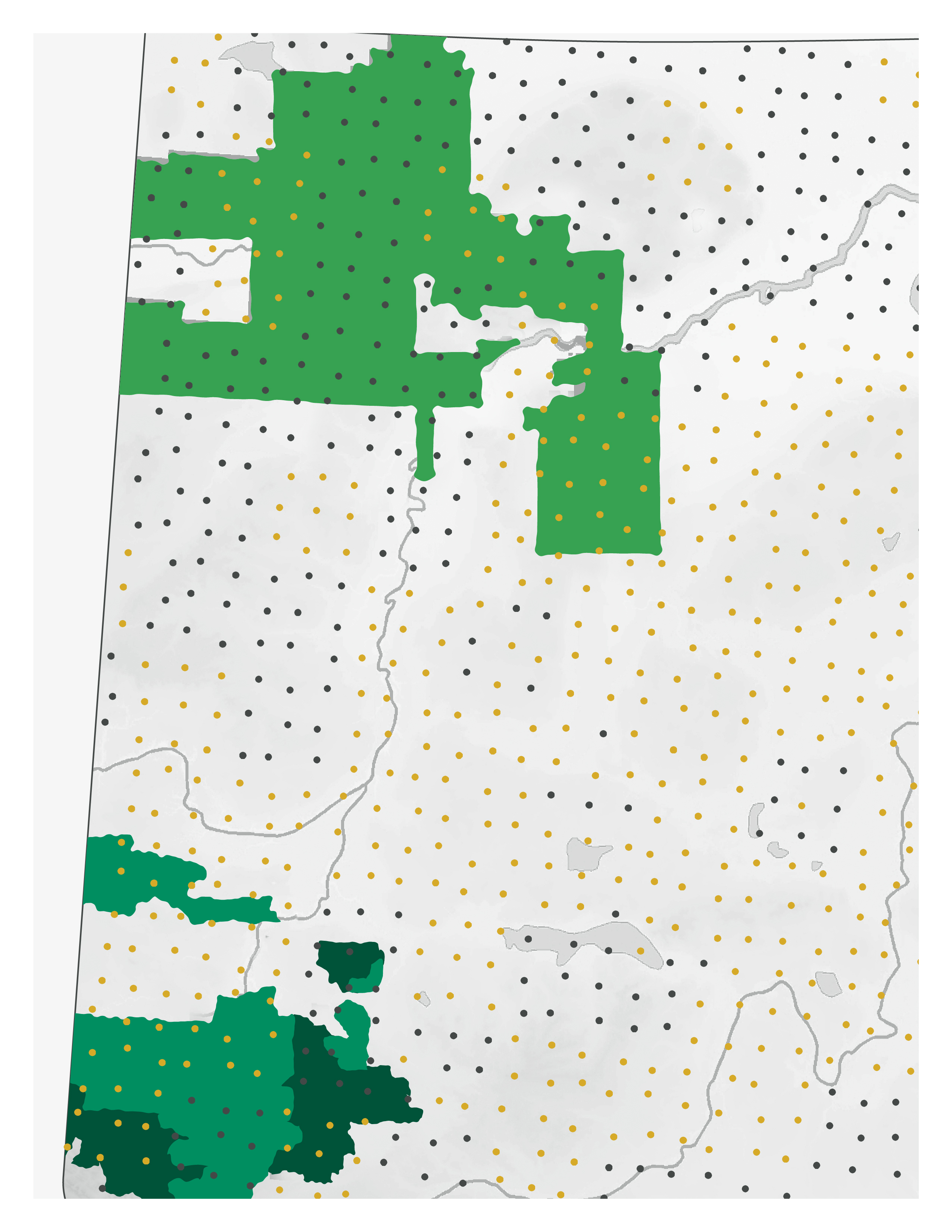
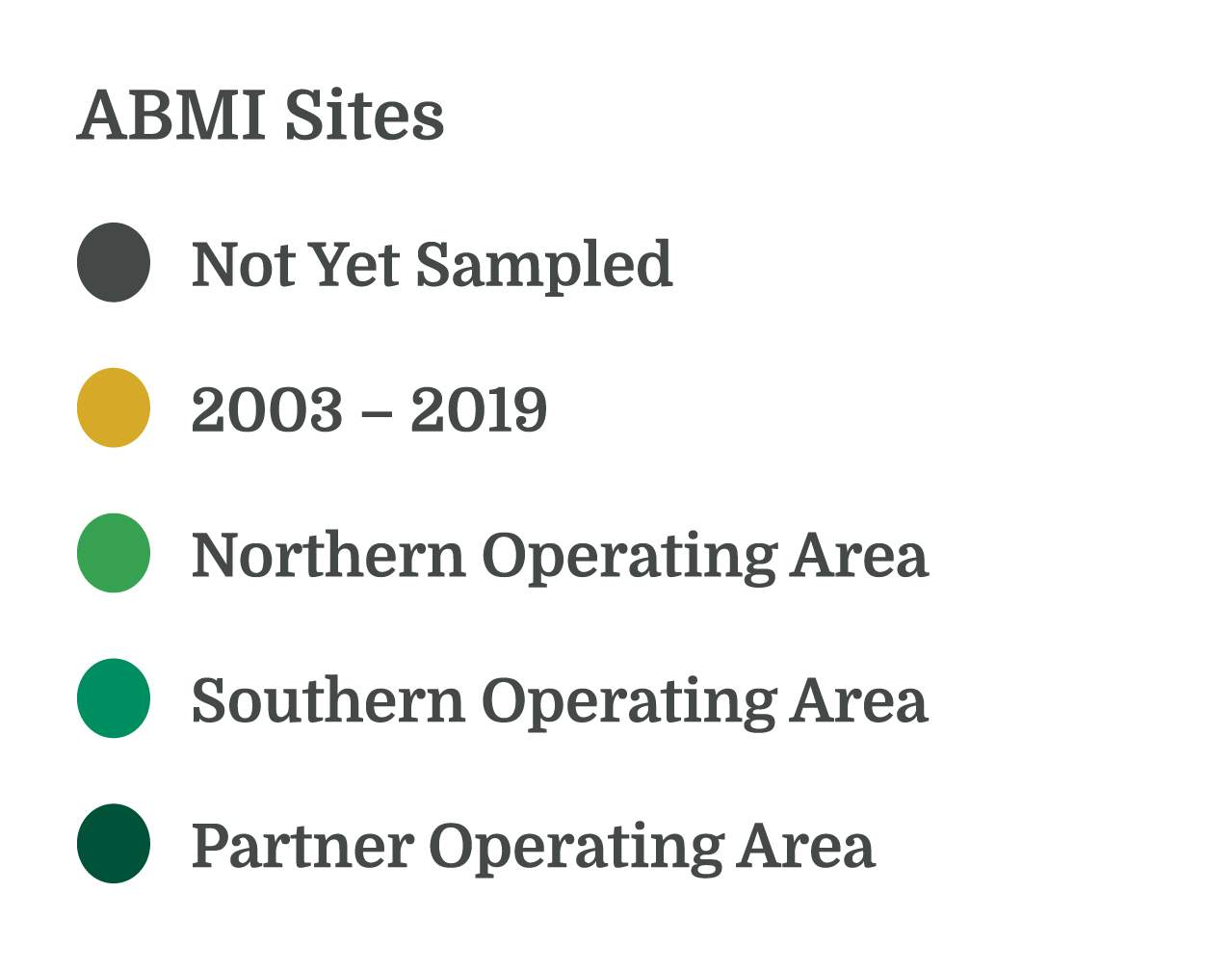
Introduction
From the boreal forest in the north to the grasslands in the south, the ABMI monitors the state of Alberta’s biodiversity. Through our field and laboratory efforts, the ABMI has detected over 3,000 species in Alberta.
The ABMI employs a systematic grid of 1,656 site locations, spaced 20 km apart, to collect biodiversity information, including species and habitat data, at both terrestrial and wetland sites[1]. The ABMI also monitors at additional 'targeted' sites as needed to address additional monitoring and research objectives.
At each location, ABMI technicians record the species that are present, and measure a variety of habitat characteristics. For species that cannot be identified in the field (e.g., mites and lichen), ABMI taxonomists sort, identify, and archive samples to complete the Institute’s species-level dataset.
Methods
Click on a tab to review a summary of methods and analysis for human footprint, linear features, interior native habitat, biodiversity intactness, and sector effects:
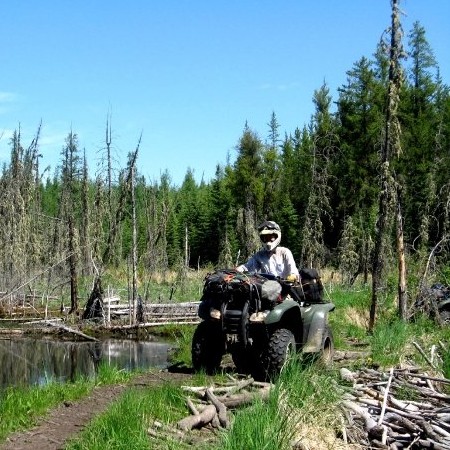 Photo: ABMI
Photo: ABMI
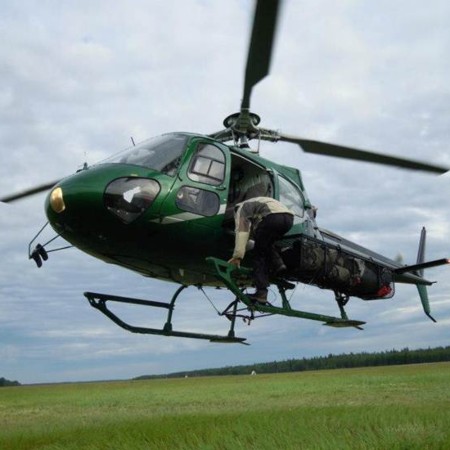 Photo: ABMI
Photo: ABMI
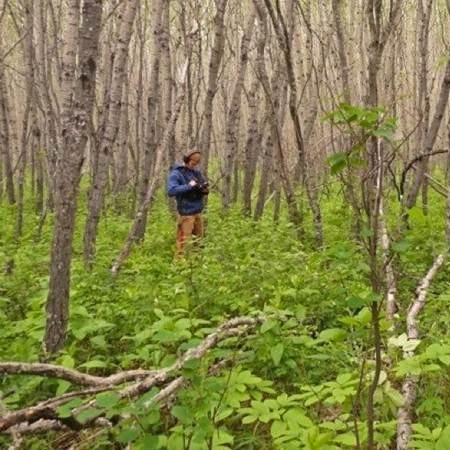 Photo: ABMI
Photo: ABMI
- Human Footprint
- Linear Features
- Interior Native Habitat
- Biodiversity Intactness
- Sector Effects
- Landbase Change Attribution
Measuring Human Footprint
The ABMI defines human footprint as the visible alteration or conversion of native ecosystems to temporary or permanent residential, recreational, agricultural, or industrial landscapes. The definition includes all areas under human use that have lost their natural cover for extended periods of time, such as cities, roads, agricultural fields, and surface mines. It also includes land that is periodically reset to earlier successional conditions by industrial activities such as forest harvest areas and seismic lines. Some human land uses, such as grazing, hunting, and trapping, or the effects of pollution, are not yet accounted for in our human footprint analyses.
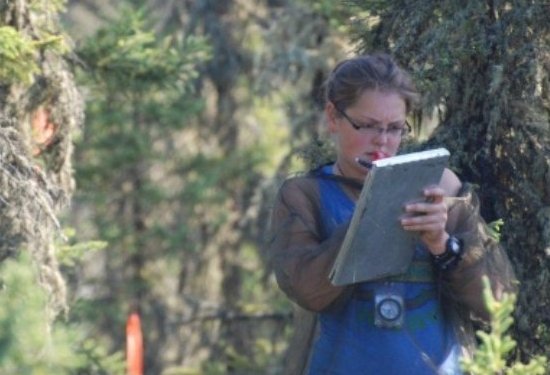 Photo: ABMI
Photo: ABMI
Human Footprint Categories
Human footprint is divided into nine categories for analysis:
 Agriculture Footprint
Agriculture Footprint
Areas of annual or perennial cultivation, including crops and tame pasture, as well as confined feeding operations and other high-density livestock areas.
 Energy Footprint
Energy Footprint
Areas where vegetation or soil has been disturbed by the creation of mine sites, peat mines, pipelines, seismic lines, transmission lines, well sites, and wind-generation facilities. This footprint type is called “energy footprint” because most of this footprint type is associated with the energy industry.
 Forestry Footprint
Forestry Footprint
Areas in forested landscapes where timber resource extraction has occurred for industrial purposes, including clear-cut and partial-cut logging methods.
 Effective Forestry Footprint
Effective Forestry Footprint
The area of forestry footprint pro-rated for how much it has recovered for biodiversity, based on harvest area age and stand type (deciduous or conifer). A newly harvested area is considered to be 0% recovered, while mature forest is 100% recovered.
 Human-created Waterbodies
Human-created Waterbodies
Human-created waterbodies used for a variety of purposes, such as to extract fill (borrow-pits, sumps), water livestock (dugouts), transport water (canals), meet municipal needs (water supply, sewage), and store water (reservoirs).
 Transportation Footprint
Transportation Footprint
Railways, roadways, and trails with hard surfaces such as cement, asphalt, or gravel, roads or trails without gravel or pavement, and the vegetation strips alongside transportation features.
 Urban/Industrial Footprint
Urban/Industrial Footprint
Combines urban, rural, and industrial footprint types including residences, buildings, and disturbed vegetation and substrate associated with urban and rural settlements, such as housing, shopping centres, industrial areas, golf courses, and recreation areas, as well as bare ground cleared for industrial and commercial development.
 Total Human Footprint
Total Human Footprint
Summary of six human footprint categories combined: agriculture, energy, forestry, human-created waterbodies, transportation, and urban/industrial.
 Effective Human Footprint
Effective Human Footprint
Same definition as Total Human Footprint but replacing Forestry Footprint with Effective Forestry Footprint.
How Human Footprint is Analyzed
The ABMI monitors the status of Alberta’s human footprint using satellite imagery at two spatial scales:
3 x 7-km Samples
The ABMI uses human footprint data measured annually at a 1:5,000 scale to track changes in human footprint over time. Detailed annual samples of human footprint are measured in a 3 × 7-km rectangular area centered near each of the ABMI’s 1,656 sites, which when summed across all sites amounts to about 5% of the province’s land surface. ABMI human footprint trend data are available from 1950 to 2019. Trend data and the metadata associated with these data can be accessed here.
Provincial Scale
At the provincial scale, the ABMI merges 20 human footprint sub-layers (based on 117 feature types) into a single integrated layer by applying a specific order of precedence to create the ABMI Human Footprint Inventory (HFI), circa 2018. Some of these 20 sub-layers are created by the ABMI and Government of Alberta as part of the Alberta Human Footprint Monitoring Program. We use the HFI 2018 for two purposes in this report: to generate maps of human footprint in Norbord’s operating areas, and to standardize the 3 × 7-km trend estimates before reporting. This product is updated approximately every two years; these data and the metadata associated with this product are available here.
Human Footprint Recovery
As a successional footprint, forestry recovers with time after disturbance. To account for this recovery, we summarize “recovered forestry”—defined as Effective Forestry Footprint in this report—prorating the effects on biodiversity of older harvested areas using biotic recovery curves based on a literature review[2]. Because results show faster recovery in deciduous forest than in conifer forest, we apply different recovery curves for these two forest types. We do not yet have information on recovery of other types of human footprint.
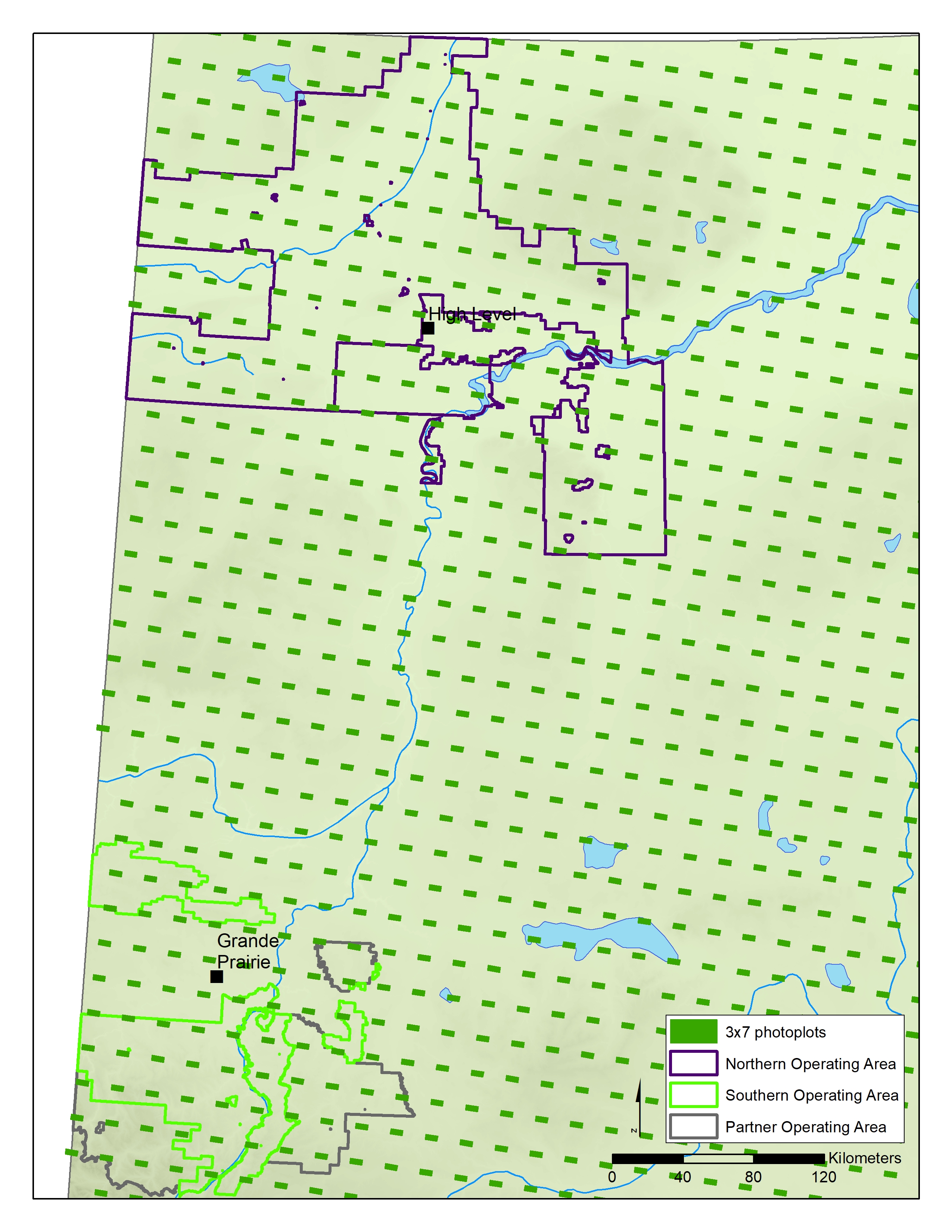
How Human Footprint is Reported
To report on the status of human footprint, the ABMI presents the percentage of land directly altered by human activities, ranging from 0% (no visible human footprint) to 100% (completely modified by human footprint). In general, cities and cultivated fields have high human footprint, while protected and undeveloped areas have low human footprint. Human footprint is summarized for total human footprint and by the six reporting categories.
Trend in human footprint in Norbord’s operating areas was assessed using the 3 × 7-km detailed inventory of human footprint available from 1950 to 2019. Trend is presented for total human footprint, effective human footprint, and by the seven reporting categories.
For forestry footprint and total human footprint (both status and trend), we also report on the area of their respective footprints after reducing the area of older forestry footprint based on how recovered it is, referred to as Effective Forestry Footprint and Effective Human Footprint.
The maps used to visualize human footprint in this report are based on the GIS Inventory of Provincial Human Footprint, circa 2018.
Linear Feature Categories
Linear disturbance is summarized as the density of linear footprint in km per km2.
This work relies on partnerships with the Caribou Monitoring Unit and the Government of Alberta/Alberta Environment and Parks via the Alberta Human Footprint Monitoring Program. More details are available in Collaborators and Contributors.
Linear feature types are divided into the following categories for analysis:
 Seismic Line (Conventional)
Seismic Line (Conventional)
Seismic lines constructed prior to the use of Low-Impact-Seismic (LIS) construction methods. Conventional seismic lines were constructed using older technology that required the lines to be 5 to 8 meters in width to allow equipment to operate on the lines.
 Pipeline
Pipeline
A line of underground and overground pipes, used for the delivery of petrochemicals, as well as the physical clearing around the pipeline(s).
 Roads Major
Roads Major
All roadways paved with asphalt or concrete, roads surfaced with gravel and which serve as a main access route, as well as aircraft runways and interchange ramps.
 Roads Minor
Roads Minor
Roadways surfaced with dirt and/or low vegetation which serve as minor access routes.
 Transmission Lines
Transmission Lines
Utility corridors greater than 10 m wide with poles, towers, and lines for transmitting high voltage (> 69 kV) electricity.
 Railway
Railway
A road or track for trains including active and abandoned tracks.
Total Linear Footprint
Summary of all linear footprint categories combined.
Interior Native Habitat
The ABMI Human Footprint Inventory (HFI) allows areas of native terrestrial habitat to be identified—in other words, those areas in the province that have not been visibly disturbed by humans, although natural disturbances (e.g., wildfire, insect outbreaks) and invisible effects of humans (e.g., pollution) still occur.
Further, the ABMI can track the amount of interior native habitat that is effectively “away” from the influence of human footprint due to edge effects. To report on the status of native vegetation, we present:
- The percentage area of land cover that has no visible human footprint (although land uses like grazing may still occur).
- The percentage area of interior native vegetation using three edge distances applied outwards from human footprint—50 m and 200 m following recommendations from Huggard and Kremsater (2015)[3], and 500 m to represent the longest reported edge effects, such as those for Woodland Caribou. These three edge distances are called “base” distances. The base distances are narrowed to account for two factors (Huggard and Kremsater (2015)[3] for detailed methods):
Width of Human Footprint
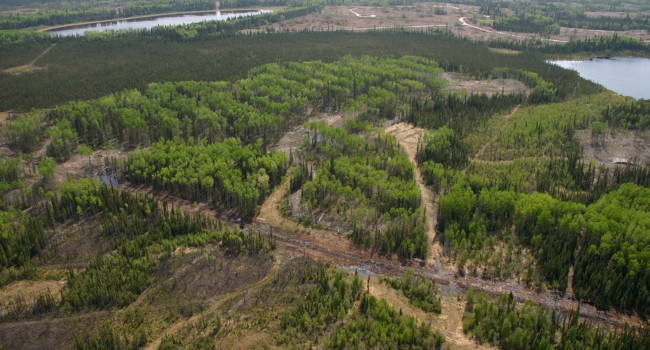 Photo: Pembina Institute
Photo: Pembina Institute
For narrow human footprint types like linear features, the edge influence that extends into native habitat is reduced because these openings have little surface wind, are shaded in most orientations, and are considered to be under “forest influence” for many species.
Recovery of Successional Footprint
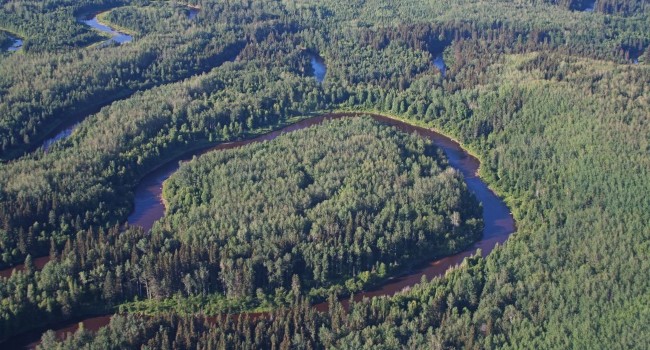 Photo: Diane Haughland
Photo: Diane Haughland
The edge distance is reduced as forestry footprint recovers (ages). This calculation is currently only applied to forestry but could include any human footprint types that are non-permanent and that can recover toward natural conditions, such as reclaimed or restored seismic lines, pipelines, well pads, etc.
Biodiversity Intactness Index
The ABMI collects data on six taxonomic groups (birds*, winter-active mammals, soil mites, vascular plants, mosses, and lichens) and builds statistical models to identify how the occurrence and relative abundance of species varies in relation to native land cover, human footprints, and spatial/climate variables. For species with sufficient data, we determine cumulative effects of human footprint on species by comparing predictions under current landscape conditions to predictions in reference landscapes where all human footprints have been removed (backfilled). We convert the difference in relative abundance between predicted current and reference abundances to a scaled Biodiversity Intactness Index (BII).
Of the full suite of species assessed by the ABMI in Norbord's operating areas, we profile species associated with old deciduous (> 80 years) and old mixedwood (> 100 years) forests within birds, soil mites, vascular plants, mosses and lichens. We present results for all mammal species. Because the habitat associations of many species are poorly known, the association with old deciduous or mixedwood forest is based on our monitoring results—these are species that are more abundant in deciduous and/or mixedwood than other vegetation or HF types, and that are more abundant in old stands than mid-seral or young/cut ones. These habitat associations may change for some species as more data are collected.
* For birds, ABMI data are combined with data from the Boreal Avian Modelling Project (BAM). Within Alberta, the BAM database is a compilation of data from the Breeding Bird Survey (BBS), Breeding Bird Atlases, Environment and Climate Change Canada (ECCC), the Bioacoustic Unit at the University of Alberta, other monitoring projects, and short-term research projects. More details are available in Collaborators and Contributors.
How Biodiversity Intactness Index is Calculated
For a detailed description of methods, see Azeria et al. (2019)[4].
The BII is scaled between 0 and 100, with 100 representing no difference in expected abundance between current and reference conditions, and 0 representing current species abundance as far from reference conditions as possible. Intactness thus reveals deviations in species' abundance from intact conditions. Both downwards and upwards differences from reference conditions are viewed as deviations from intact conditions. For example, an intactness value of 50% means that the current species abundance is either half or twice as abundant as that predicted under reference conditions. The index is calculated as:
- current / reference × 100%, when current < reference (these are "decreaser" species whose relative abundance is lower in human footprint compared to reference conditions), or
- reference / current × 100%, when reference < current (these are "increaser" species whose relative abundance is higher in human footprint compared to reference conditions).
Overall intactness for a region is calculated by averaging intactness of species within each taxonomic group, then averaging the six taxonomic groups. Because increasers and decreasers both reduce intactness, a predicted increase in one species does not cancel out a predicted decrease in another species. Instead, both reduce intactness. We estimate intactness for 2018, based on native land cover and human footprint for 2018.
Limitations
Intactness results are averages for the Northern Operating Area, Southern Operating Area, and Partner Operating Area. Specific locations within this region are nearly 0% intact (e.g., active industrial sites), and other sites are 100% intact (e.g., undeveloped forest and wetland habitat).
Any interpretations of biodiversity intactness must take the following into account:
- Intactness is based on species-habitat models that will change as analyses are refined and as more data are gathered.
- Intactness only shows the predicted effects of visible human footprint. Species' populations change for many other reasons. A "decreaser" species—one with lower abundance in human footprint—may in fact have an increasing population trend, if other aspects of its environment are improving. And vice versa for an "increaser" species. Measuring the actual trends of species is a long-term goal of ABMI monitoring.
- Intactness maps show the predicted average effect of the types of footprint in each area. We do not have information on the exact effects of footprint in each specific area, and we do not monitor actual changes in species in every location.
- Our models only reflect the immediate local effects of human footprint. There may be additional large-scale effects that we do not account for. For example, an extensive network of linear features and other human footprints may allow a species that prefers disturbed areas to spread through a region.
- This approach does not account for non-footprint effects (e.g., pollution, noise).
Sector Effects
The ABMI combines our well-developed habitat models for species with landbase information to infer the effects of different industrial sectors on many species[4,5]. The ABMI uses models and predictions to estimate the effects of individual industrial sectors (i.e., a set of human footprint categories associated with each industrial sector) within Norbord's operating areas. We started with a summary of all “transitions” of native landcover types (backfilled vegetation) to footprint types (circa 2018). We then selected the footprint types associated with a single industrial sector and compared the expected current (including footprint) and reference species abundance (footprint backfilled). This showed the degree to which the footprint from just that one industrial sector is expected to have changed the abundance of species. We did this calculation for each major industrial sector including: agriculture, forestry, energy, urban/industrial, and transportation.
Reporting on Sector Effects
The ABMI reports on two aspects of these “sector effects”: local scale effects and regional population effects.
Local Scale Effects
Local scale effects focus on differences in expected abundance between current and reference land base inside the boundaries of the footprint polygons of each sector. This summary refers to a regional average of the impacts due to land cover transformation from native vegetation to a given footprint type without regard to the impact of other sectors’ footprint types and native vegetation (areas outside of any current footprint) in the region.
Values indicate how much the abundance of a species is expected to differ in the exact areas where a sector’s footprint occurs. It is the difference between the abundance of a species in the expected native habitat prior to the footprint and its abundance in the sector’s footprint type. Results are interpreted as follows:
- If a species does not live in the disturbance at all, the local effect is -100%.
- If the species is a generalist whose abundance is not expected to differ between native habitat and footprint, the effect is 0%.
- If a species is favored more by footprint than native habitat, the effect is a positive percentage.
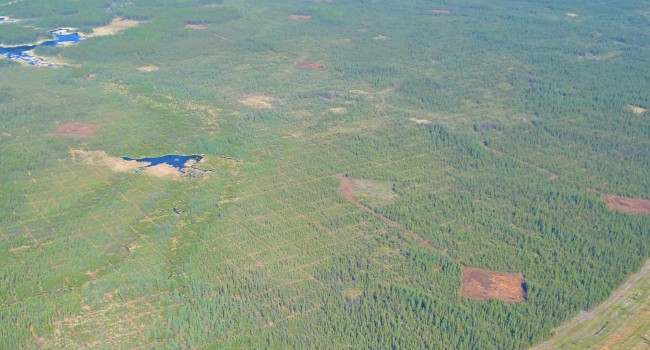 Photo: Sara Venskaitis
Photo: Sara Venskaitis
Regional Population Effects
A sector’s effect on the regional population of a species shows how much the total population in the region is expected to have changed due to that sector’s footprint in the region. It is the difference between the species’ estimated total abundance in a reference landscape from which all human footprint has been removed, and the reference landscape with just that sector’s footprint added back in. Three factors determine a sector’s effect on the regional population of a species:
 Photo: WildTrax
Photo: WildTrax
- How much area is occupied by footprint from that sector. All else being equal, the more area a sector’s footprint occupies, the more effect it will have on the species;
- How strongly—positively or negatively, or a mix of both—the species responds to each of the sector's footprint types;
- How much of the sector's footprint is in higher- versus lower-quality habitat for the species. For example, species that live in old upland forest may be more affected by the forestry sector than the energy sector, because forestry focuses disturbance in older stands.
The species most negatively affected by an industrial sector will therefore be species that are least tolerant of that sector’s footprint, and that prefer to live in habitat types where more of the sector’s footprint occurs.
Calculation of Sector Effects
Step 1. We develop habitat models for species based on ABMI field data.
Step 2. We define 6 industrial sectors:
- Agriculture: Cultivated crops or pastures.
- Forestry: Age and stand type of harvest areas are tracked to account for recovery.
- Energy: Mines, well sites, pipelines, transmission lines, seismic lines and associated facilities.
- Rural/Urban: Residential, industrial or recreational sites in rural or urban areas.
- Transportation: All roads and rail lines. We cannot distinguish roads made specifically for other sectors, such as roads to access harvest areas or well sites.
- Human-created waterbodies: Larger bodies of water created by different sectors.
- Miscellaneous (not reported): Unidentified human footprint.
Step 3. We use ABMI’s reference map of current native vegetation with human footprint removed, and create another map with a sector’s footprint added back in.
Step 4. We apply the habitat models to predict a species’ abundance in the reference map and the reference map plus the sector’s footprint. We use the differences in abundance in just the areas with the sector’s footprint to calculate the local footprint effect. We use the differences in total abundance over the whole region to calculate the sector’s effect on the regional population of the species.
 Photo: Sonya Poller
Photo: Sonya Poller
Caveats
There are two important caveats for the sector effects:
- The results are based on applying our habitat models to landbase information. The models have statistical uncertainty, and there may be errors in the landbase information. We do not yet have direct field measurements on actual trends in species’ abundances related to different industrial sectors.
- This is a fairly simple approach that does not account for non-footprint effects (e.g., pollution) or complexities like interactions between sectors (e.g., weedy species entering one sector’s footprint after they were introduced by another sector). We also have to use rules to account for areas where different sectors overlap (e.g., a well site in a cultivated field, forest harvest prior to an industrial development).
Attribution of Landbase Change
The ABMI is continuing to collect data to meet our long-term goal of showing trends in species’ abundances. Until those direct trend estimates are available, we can report trends predicted from changes in the landbase. We used habitat models for species to predict their abundance using complete maps of native vegetation and human footprint in each Norbord area in 2010, and then again for 2018, and report the predicted change in the species over that time. We are able to do further summaries that attribute the overall predicted change in a species to different types of change on the landbase, including:
- New Forestry: Areas harvested between 2010 and 2018.
- Old Forestry: Areas harvested prior to 2010 that continued regenerating from 2010 to 2018.
- New Non-forestry Human Footprint: Non-forestry human footprint added between 2010 and 2018.
- Old Non-forestry Human Footprint: Non-forestry human footprint from before 2010 that either changed type or that disappeared from the landbase.
- Fire: Native stands or human footprint areas (including forestry) that burned between 2010 and 2018.
- Aging of Undisturbed Stands (Aging): Native stands that were undisturbed and continued to age between 2010 and 2018.
- Other: Undisturbed non-forested native habitat (e.g., marshes, grassland). Because these areas have no age, this part of the landbase doesn’t change over time and is not included in the results.
Reporting on Attribution of Landbase Change
The ABMI reports on two aspects of landbase change: effects of landbase change on individual species and a roll-up of results for all bird species and habitat elements.
Individual Species Effects
We use “vector diagrams” to show the effects of each type of landbase change on individual bird species and habitat elements. To interpret the vector diagrams, follow the arrows from the top of the figure, starting at 0% change, to the bottom to see the predicted effects on the species of:
- new forestry, then
- the additional effect of old regenerating harvest areas, then
- new non-forestry human footprint, then
- changes or disappearance of old non-forestry human footprint, then
- fires, and finally
- aging of undisturbed native forest.
The endpoint is the net change predicted in that species from 2010 to 2018.
Roll up of Landbase Change Effects
In this section we present roll-up figures for all bird species showing the effects of:
- New versus regenerating old forestry,
- Fires versus aging undisturbed stands,
- Net human footprint versus net natural changes.
Caveats
There are three important caveats for the landbase attribution analysis:
- These changes reflect the predicted changes in species due to changes in the landbase that we can map. Many other factors can also change species’ populations. We will be able to look into those when we have direct trend information, which we can then compare to the changes predicted from landbase change.
- These predicted effects of landbase change are based on the period 2010-2018. Harvest rates, and particularly fires, vary over time. ABMI will soon have province-wide mapping for the year 2000, so that we can extend the attribution analysis over a longer time period.
- The results are based on ABMI habitat models, which are imperfect and improve over time as we collect more data.
Our Data Partners
We are thankful to the many organizations and institutions that contribute information to the ABMI, supporting analyses and results found in this report and elsewhere. These partnerships make the ABMI, and its data and information products, stronger.
For this report, we particularly acknowledge the contributions of the Boreal Avian Modelling Project, Environment and Climate Change Canada, members of the Applied Geospatial Research Group at the University of Calgary, the Caribou Monitoring Unit, the Bioacoustic Unit, and Alberta Environment and Parks.
More information on our data partners is given on the Collaborators and Contributors page.
References
A more detailed overview of the methods used to produce the ABMI's species-habitat models and Intactness Index is available on the main ABMI website.
Additionally, the following resources were referenced in this report:
Alberta Biodiversity Monitoring Institute. 2014. Terrestrial field data collection protocols (abridged version) 2018-05-07. Alberta Biodiversity Monitoring Institute, Alberta, Canada. Report available at: abmi.ca.
Huggard, D. and L. Kremsater. 2015. Human footprint recovery for the Biodiversity Monitoring Framework - Quantitative Synthesis. Unpublished Report.
Huggard, D. and L. Kremsater. 2015. Recommendations for forest interior and old-forest indicators for the Biodiversity Management Framework. Unpublished Report.
Azeria, E.R., P. Sólymos, D.J. Huggard, M-C. Roy, and J. Schieck. 2019. Detailed methods and results for predicting species status and relationships. Technical Report available at: https://abmi10years.ca/10-year-review/resources/.
Sólymos, P. and J. Schieck. 2016. Effects of industrial sectors on species abundance in Alberta. ABMI Science Letters, Issue 5: October, 2016.





